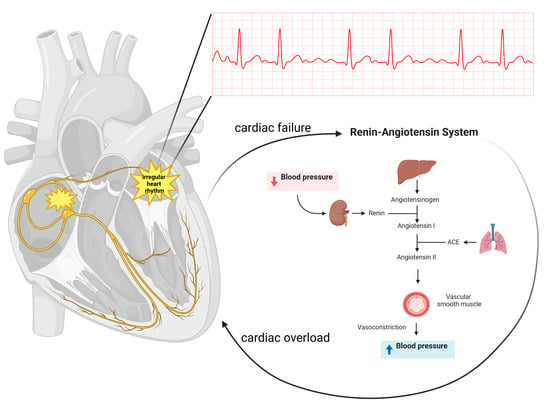Available attempts to determine the frequency of IAF involve different study groups, frequently over many years, often grouping patients with comorbidities [
24,
107,
108,
109,
110]. Therefore, the frequency of IAF more than once ranges in probability from 1.4% to 27.59% [
111,
112,
113]. The increased risk of AF consists, for example, of cardiovascular diseases such as hypertension or valvular disease [
19,
24,
107]. Moreover, in at-risk groups, lower VitD values contributed to an increased incidence of IAF [
107]. In addition, as VitD deficiency worsened, which is also associated with elevated PTH levels, the incidence of AF also increased [
114]. To determine the level of deficiency, observational studies use a similar classification to PoAF. Again, [25(OH)D2] values <20 ng/mL are predictive of AF incidence [
19,
115,
116]. Deficient values in one study were associated with 17.2% of AF in the group, while normal values were 10.9% [
117].
4. Why Is It So Difficult to Determine the Effect of VitD on AF Incidence?—Limitations
Despite high hopes for the potential properties of VitD in reducing the likelihood of AF episodes, there is still no clear answer to the question of the VitD utility in this regard [
101,
103,
105,
120,
121,
122]. This has to do with the limitations posed to researchers by the substance itself, whose metabolism is extensive and affects numerous tissues through interactions with nuclear and membrane cell receptors [
123,
124,
125,
126]. In addition, VitD interacts with hormones that globally affect the entire body [
127,
128]. There are also technical and presumptive limitations related to the study group, the study methodology, the detection of AF and the determination of its nature, as well as how VitD is supplemented.
VitD is a substance that is subject to seasonal variations [
96,
129]. Therefore, depending on the season, it can expect different levels of VitD, and thus, there may be difficulties in adjusting the appropriate dose of supplementation [
93,
103,
108,
130]. In some cases, additional supplementation that was not included in the medical records could not be ruled out [
107,
131]. Depending on the biosynthesis and administration in food or supplements, VitD affects the degree of calcium resorption from the diet and also stimulates the release of calcium and phosphate from bone, so it is a very important element in maintaining calcium–phosphate homeostasis and musculoskeletal health [
124]. Although researchers are not sure which form, VitD2 or VitD3, supplemented most strongly influences the elevation of serum VitD concentrations, they collectively assert that many factors model the absorption of VitD from the gastrointestinal tract [
132,
133]. For VitD contained in food to be utilized, it must be released from the food. First and foremost, the presence, amount and type of fats are important for VitD, due to its hydrophobic properties [
134]. The influence of fiber, age, degree of obesity and vitamin status is also indicated [
135,
136]. The degree of hydration of vitamin D used for supplementation is also important. It has been indicated that hydroxylated vitamin D3, i.e., (25(OH)D3), has a higher potential to raise plasma VitD concentrations than nonhydrated forms [
132]. Thus, it is important to be mindful of the actual amount of VitD intake, especially since there are reports of cardiotoxic and proarrhythmic effects of too high VitD concentrations [
113]. In turn, calcium deficiency and VitD are known to cause secondary hyperparathyroidism, which results in loss of bone mass and, most importantly, is associated with a higher frequency of AF [
129]. Thus, the measurement of PTH levels is not only one of the parameters that clarifies the knowledge of VitD status but also the risk of AF [
111].
It is also necessary to discuss the limitations associated with the study group. There are papers that appear in which the limitation is still the small size of the study group as well as the very large size of the study group which is difficult to systematize [
96,
113,
140]. Therefore, it is currently more difficult and important to complete a representative group that will apply to a random patient [
25,
107,
110]. The difference in skin pigmentation is significant enough to influence the results of the study, thus obscuring important conclusions [
111,
141]. Therefore, studies on Caucasian populations, a complexion-diverse study group from Turkey, or results obtained from measurements among veterans are difficult to transfer to a random patient [
25,
107,
110,
111]. Finally, analyzing patients with comorbidities, such as hypertension, diabetes mellitus and obesity, who in addition use medications, is an important factor limiting the usefulness of the results, since these entities are factors that increase the occurrence of AF regardless of the level of VitD [
25,
97,
113,
142].
The onset of AF is associated with nonspecific symptoms, such as shortness of breath, sweats, fainting, dizziness and rapid fatigue [
143]. AF can also occur incidentally or be provoked by a cardiac procedure performed [
94,
142]. This causes many moments of AF to go unnoticed and often leaves no serious consequences, but undiagnosed AF is an important limitation in studying the impact of VitD deficiency. Therefore, ECG is used to detect AF [
143]. However, some authors have focused only on the period of hospitalization or used medical records, which are not always perfect [
87,
110]. In particular, those AFs that are paroxysmal and asymptomatic pose difficulties; however, they are those that make up a significant portion of the total, so knowing their frequency would be very valuable [
94,
108,
144]. One solution is to use Holter monitoring during hospitalization and follow-up examinations after leaving the hospital, which would allow continuous observation of the heart rhythm [
91,
93]. This would be particularly appropriate in studies focusing on the postoperative AF [
82].

